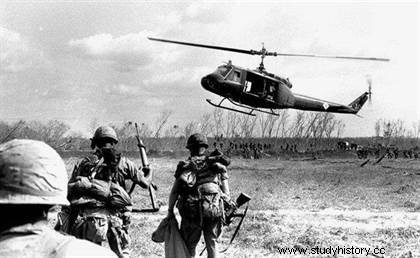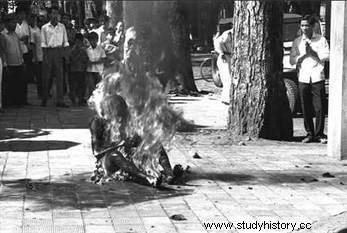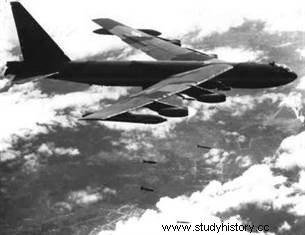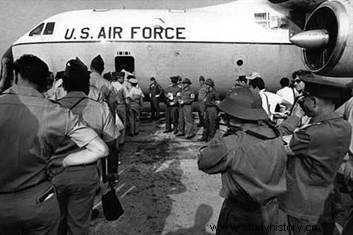 The Vietnam War (or Vietnam ) opposed, between 1959 and 1975, pro-Western South Vietnam (and its main ally, the United States) to communist North Vietnam (supported by China and the USSR). After a period of guerrilla warfare marked by the progressive infiltration of North Vietnamese forces in the South, the conflict became more radical and provoked a massive intervention by the United States. In a stalemate on the military plan and after heavy losses, the American forces will be forced to withdraw in 1973, paving the way for a reunification of the country under the leadership of the communist north.
The Vietnam War (or Vietnam ) opposed, between 1959 and 1975, pro-Western South Vietnam (and its main ally, the United States) to communist North Vietnam (supported by China and the USSR). After a period of guerrilla warfare marked by the progressive infiltration of North Vietnamese forces in the South, the conflict became more radical and provoked a massive intervention by the United States. In a stalemate on the military plan and after heavy losses, the American forces will be forced to withdraw in 1973, paving the way for a reunification of the country under the leadership of the communist north.
Origins of the Vietnam War
A former French colony under the name of Indochina, Vietnam gained its independence in 1954, after a violent war of decolonization against France (1946-1954). According to the peace agreements signed in Geneva in July 1954, the country is divided into two zones, north and south, at the height of the 17th parallel (a line of geographical latitude). It was also agreed that general elections should be held within two years to reunite the country. Because of the refusal of the South Vietnamese government to organize these elections, the Communist government of Hanoi, which had been careful not to dismantle its networks in the South, undertook from 1957 to achieve the unity of Vietnam by the subversion of the authority of Saigon. This enterprise was favored by the discontent aroused by the Diem regime and by the misery of the rural populations of the South.
 The various groups of opponents to Diem, which the government of Saigon confused, from 1959, under the name of Viet Cong (“Vietnamese communists”), formed on December 20, 1960 during a clandestine congress the National Front for the Liberation of South Vietnam (F.N.L.). It had genuine non-Marxist nationalists, but increasingly came under Communist rule. In February 1961, the F.N.L. acquired a liberation army of South Vietnam, and, with the human and material help provided by the North, the guerrilla operations, begun in 1957, took the form of a real war.
The various groups of opponents to Diem, which the government of Saigon confused, from 1959, under the name of Viet Cong (“Vietnamese communists”), formed on December 20, 1960 during a clandestine congress the National Front for the Liberation of South Vietnam (F.N.L.). It had genuine non-Marxist nationalists, but increasingly came under Communist rule. In February 1961, the F.N.L. acquired a liberation army of South Vietnam, and, with the human and material help provided by the North, the guerrilla operations, begun in 1957, took the form of a real war.
Faced with this situation, the Kennedy administration provided increased assistance to the South Vietnamese government. By the end of 1961, the number of American military "advisers" in South Vietnam had reached 15,000 men, and in February 1962 an American military command was created in that region. The opposition against the Dam regime had taken on such magnitude (from May 1963, a wave of spectacular suicides of monks who publicly set themselves on fire) that Kennedy decided to abandon Diem and let the coup take place (if not favored it). military state which cost the life of the South Vietnamese dictator (November 1, 1963). The fall of Diem was to be followed for two years by a series of coups d'etat which contributed to the aggravation of disorder in South Vietnam. Authority was only restored in Saigon in June 1965, when General Thieu became Head of State.
American Climbing
What was to be called the American "escalation" in Vietnam had begun following a naval incident which on August 5, 1964 opposed in the Gulf of Tonkin two American destroyers to the North Vietnamese fleet. Although false (or at least exaggerated), the president's announcement has the effect of a bomb in the United States. Immediately, the American Congress) votes the intensification of the American engagement in Vietnam. In retaliation for the attack on their ships by the North Vietnamese, the Americans launched their first air attack north of the 17th parallel.
From February 1965, the American air force carried out systematic raids on the North. In June 1966 it even attacked Hanoi and Haiphong. The intervention of the American ground forces in the combats in South Vietnam began in March 1965, and, from this moment, the American manpower did not cease increasing, increasing from 23,000 men at the beginning of 1965 to 267,000 by the middle. in 1966 and 542,000 men in 1969.
 South Korean, Australian and New Zealand troops were also engaged alongside the South Vietnamese. Despite the scale of the means involved and their technological superiority, the Americans did not obtain any decisive results, the Vietcong forces and the North Vietnamese troops receiving from the communist countries modern equipment and also benefiting from their long experience in guerrilla warfare. .
South Korean, Australian and New Zealand troops were also engaged alongside the South Vietnamese. Despite the scale of the means involved and their technological superiority, the Americans did not obtain any decisive results, the Vietcong forces and the North Vietnamese troops receiving from the communist countries modern equipment and also benefiting from their long experience in guerrilla warfare. .
At the beginning of 1968, North Vietnamese and Vietcong troops launched a major offensive against South Vietnamese cities, in the hands of the American-Southern coalition. Vietnamese:it is the Tet offensive. The fighters seized strategic buildings, which they sometimes held for nearly a month, as in the city of Huê. The recapture of Huê by the Americans was made at the cost of bloody street battles. The Tet offensive demonstrated to the Americans the power of their adversary. The Vietnam War deeply divided American opinion, sparking a protest movement in the United States in 1965 that was to grow, and affected America's international prestige.
The laborious peace negotiations
Moving towards the search for a negotiated solution, President Johnson decided to partially halt the aerial bombardment of the North (March 31, 1968). Opened in Paris on May 13, 1968 between Americans and North Vietnamese (which were joined in January 1969 by South Vietnamese and F.N.L.), the peace talks were to drag on for nearly five years. During this period, the United States opted for "Vietnamization", which consisted of gradually withdrawing its forces from South Vietnam by giving the South Vietnamese army sufficient means to fight alone against the Communist forces.
 After the total cessation of American raids against North Vietnam, decided in November 1968 by President Johnson. Nixon, newly elected, began the repatriation of American forces (June 1969). On the other hand, the Communists in no way slowed down their offensive actions, which forced the Americans to intervene in Cambodia (1970) then to resume their air attacks against the North, to block the ports of North Vietnam (May 1972) and to submit Hanoi and Haiphong to the heaviest bombardment they had seen in the entire war.
After the total cessation of American raids against North Vietnam, decided in November 1968 by President Johnson. Nixon, newly elected, began the repatriation of American forces (June 1969). On the other hand, the Communists in no way slowed down their offensive actions, which forced the Americans to intervene in Cambodia (1970) then to resume their air attacks against the North, to block the ports of North Vietnam (May 1972) and to submit Hanoi and Haiphong to the heaviest bombardment they had seen in the entire war.
However, the secret negotiations opened in August 1969 on the sidelines of the Pans conference, between Kissinger and Lê Duc Tho, ended up leading to the signing of the Paris Accords (27 January 1973), following which American soldiers withdrew from Vietnam within two months. These agreements also established a ceasefire between the various opposing Vietnamese forces and included political clauses with a view to national reconciliation. They were not respected by either the North or the South, who tried instead to improve their positions.
The F.N.L., which had constituted itself as a Provisional Revolutionary Government (G.R.P.) in June 1969, continued to receive reinforcements of troops and equipment from North Vietnam. The regime of South Vietnam, highly corrupt, will prove incapable of holding on, despite American logistical support, in the face of combined pressure from the Viet Cong. At the end of 1974, the Communists resumed the offensive on a large scale. In the spring of 1975, they seized Hue (March 24) and Da Nang (March 29), causing the general collapse of the South Vietnamese army. Too late, the resignation of President Thieu (April 21) did not allow the opening of political negotiations.
The end of the Vietnam War
 While the Khmer Rouge had already overwhelmed Cambodia, the Communists entered Saigon on April 30, 1975. The second Vietnam War ended with the complete victory of communism not only in Vietnam, but in all of Indochina. Beyond ideologies, this conclusion confirmed the constant of Vietnamese history, the domination of the South by the North, which is more authoritarian and more centralized. Saigon, renamed "Ho Chi Minh City", was purged of traces of Western presence, and socialist structures were gradually put in place in South Vietnam.
While the Khmer Rouge had already overwhelmed Cambodia, the Communists entered Saigon on April 30, 1975. The second Vietnam War ended with the complete victory of communism not only in Vietnam, but in all of Indochina. Beyond ideologies, this conclusion confirmed the constant of Vietnamese history, the domination of the South by the North, which is more authoritarian and more centralized. Saigon, renamed "Ho Chi Minh City", was purged of traces of Western presence, and socialist structures were gradually put in place in South Vietnam.
The reunification of Vietnam was to take place, through elections scheduled for the first half of 1976, and it was already decided that Hanoi would be the capital of Vietnam reunified. On April 25, 1976, for the first time since the consultation of January 8, 1946, North Vietnamese and South Vietnamese elected a single National Assembly. Two months later, this Assembly adopted a new Constitution and ratified the reunification of the country.
This conflict, certainly one of the most famous of the 20th century, stands out for its media coverage and the role played by American public opinion. Extremely violent, marked by numerous abuses, it caused several million victims (including a large majority of Vietnamese civilians), the American army suffering its heaviest losses (58,000 dead) since the Second World War.
This war will leave a deep trauma in American consciences. In reunified Vietnam that had become a socialist republic, “re-education” camps multiplied and quickly thousands of opponents tried to flee the country by sea. While some Boat People were rescued by organizations non-governmental, many die, victims of pirates and starvation.
Bibliography
- The Vietnam War:A Deadly Conflict at the Heart of the Cold War, by Mylène Théliol. 50 minutes, 2017.
- Indochina and Vietnam:35 Years of War:1940-1975, by Dennis Wainstock and Robert Miller. New World, 2019.
- The Vietnam War and American Public Opinion 1961-1973. Sorbonne Press, 1995.
To go further
- The Vietnam War, documentary by Daniel Costelle and Isabelle Clarke. DVD, 2015.
